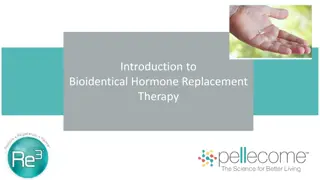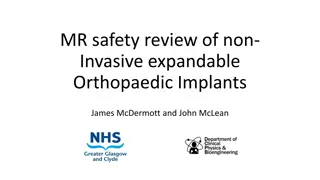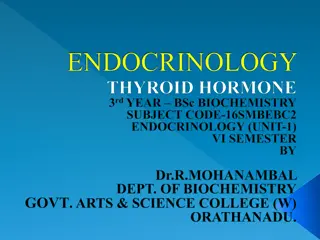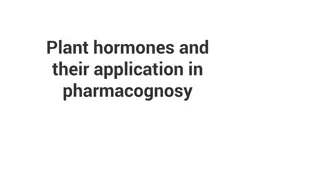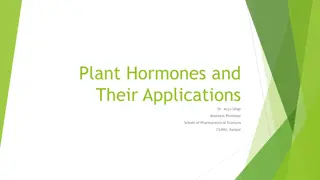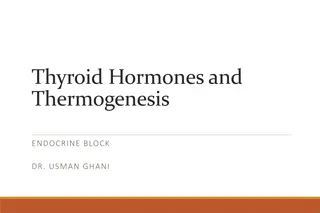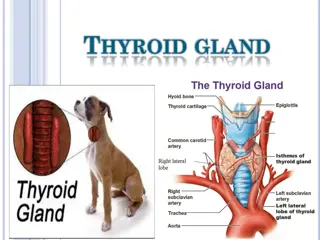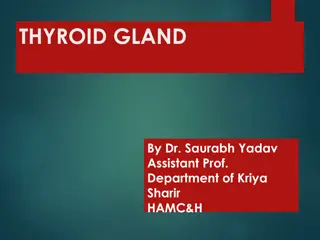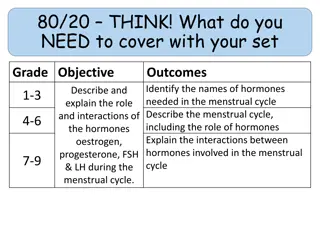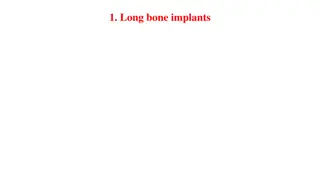Understanding Hormones in Implants and Their Relationship to Cancer Risk
Hormones found in implants and naturally in animals and plants can impact estrogen levels, but the connection to cancer risk is complex. This article explores the presence of hormones in food, the concept of nanograms, human estrogen production, and the implications of using implants in beef production.
Download Presentation

Please find below an Image/Link to download the presentation.
The content on the website is provided AS IS for your information and personal use only. It may not be sold, licensed, or shared on other websites without obtaining consent from the author. Download presentation by click this link. If you encounter any issues during the download, it is possible that the publisher has removed the file from their server.
E N D
Presentation Transcript
Whats all the fuss? Implants contain hormones Hormones may contribute to cancer then do implants have anything to do with cancer?
Is Implanted Beef Safe? 3 oz serving of unimplanted beef = 1.3 ng estrogen 3 oz serving of implanted beef = 1.9 ng estrogen
Whats a Nanogram? Nanogram per gram = 1 part per billion (ppb) ~1 blade of grass in a football field
Other Foods 3 ounces: Unimplanted Beef Beef Milk Potatoes Peas Ice Cream Wheat Germ 1.3 ng 1.9 ng 11 ng 225 ng 340 ng 520 ng 3,400 ng
Hormones Found in ALL animals and plants Naturally-occurring Growth regulators Essential for life
Normal Human Estrogen Production Pre-pubertal male Pre-pubertal female Adult male Adult female 41,500 ng 54,000 ng 136,000 ng 480,000 ng remember 3 oz beef 1.9 ng
Normal Human Estrogen Production Pre-pubertal male Pre-pubertal female Adult male Adult female Pregnant female 41,500 ng 54,000 ng 136,000 ng 480,000 ng 3,415,000 ng Birth control pill 35,000 ng
Additive Effect Pre-pubertal male child 3 oz implanted beef 41,500 ng 1.9 ng Total 41,501.9 ng
Implication of Implants If we stopped using Implants: A serving of beef would not contain less hormones. Implants reduce the cost of beef production by ~10%. 900 lbs $1.30 /lb = $1,170 $1,170 10% = $117 That $117 would eventually come from Every cow/calf producer in the U.S.
Implication of Implants If we stopped using Implants: A serving of beef would not contain less hormones. Ranchers would take $117/head less for their calves $117 / 5 cwts = $23 / cwt ~9% price reduction
So whats it REALLY about?... Is it about hormones? We ll never eliminate hormones In our food or in our bodies
Implant Approvals Ages/Production Segments: Calves Stockers Feedlot cattle Sex: Steers Heifers Cull cows Not Bulls!
Types of Implants Estrogenic Estradiol 17- Estradiol benzoate Zeranol Androgenic Testosterone Trenbolone acetate (TBA) Combination implants
Planning the Program: Most combination feedlot implants last up to ~140 days
Planning the Program: Weaned calf (240 days from slaughter): 1. Low potency implant during backgrounding 2. Medium potency implant upon feedlot arrival 3. High potency implant ~100 days before slaughter Backgrounded calf (180 days from slaughter): Medium upon arrival High ~100 days before slaughter Long yearling (90-140 days from slaughter): High potency implant upon arrival
Conventional Implant Technology Sustained release implants Conventional Implants Ralgro, Synovex, Revalor, and Component Sustained release E2-TBA implant 90-140 days Requires a re-implant after payout For >140 day cattle
Life of an implant 30 25 Percent Improvement 20 15 10 5 0 0-35 36-70 71-105 106-140 Days
Life of an implant 35 Single Implant 30 Percent Improvement Re-implant 25 20 15 10 5 0 0-35 36-70 71-105 106-140 141-175 Days
Sustained release Implant Revalor-XS Sustained release E2-TBA implant 200+ days Like Revalor-IS (medium) w/ Revalor-S (high) reimplant on d 70 Revalor-S is coated with a soluble polymer, dissolves ~d 70
Benefits of Implants Estrogenic ADG = ~10% Feed Efficiency = ~10% Combination with Androgenic (TBA) ~15% Feed Efficiency ~15% ADG
Implants on Grass ADG 10% Lbs? Depends on base ADG 2.00 10% = 0.20 lb/day 0.20 100 days = +20 lbs in 100 days 20 lbs $1.20 = $24 / head
Benefits of Implants Minimum: $10 per $ 1 spent Typical: $20+ per $1 spent
Hypothalamus TBA:E2 Anterior pituitary Liver IGF binding protein Muscle Cells Satellite cell
Picture thisProtein deposition Implant Pounds Implant Non-implanted Implant Implanted Time
Picture thisFat deposition Implant Implant Implant
Implant growth curve Implant date kg Non-implanted Days of Life = Fat endpoint marketing target
Placement of Implant Only approved location: Middle third of the back side of the ear Ear is removed and discarded at time of slaughter, reducing any food supply risk
Return from implants: Suckling: 10-30 lbs Stocker / backgrounding: 20-30 lbs Finishing: 40-150 lbs, depending on days on feed Yearlings: 40-50 lbs 60-100 lbs 100-150 lbs 4-500 lb calves: Calf-fed Holsteins:
Take Homes: Implants use hormones similar / identical to those already in the beef animal Implants improve lifetime cost efficiency of beef production by ~10% Implants act using other messenger systems in the body to affect growth
Take Homes: Coated implants increase the duration of release of combination E2-TBA implants
Take Homes: Hormones ARE NOT the issue! Estrogen content of many other foods is many times higher than beef But that s not a problem either. Your body produces several hundred thousand or MILLION times as much every day! The Issue is: Beware of Who is on the sending end of the message and always question motivations.




